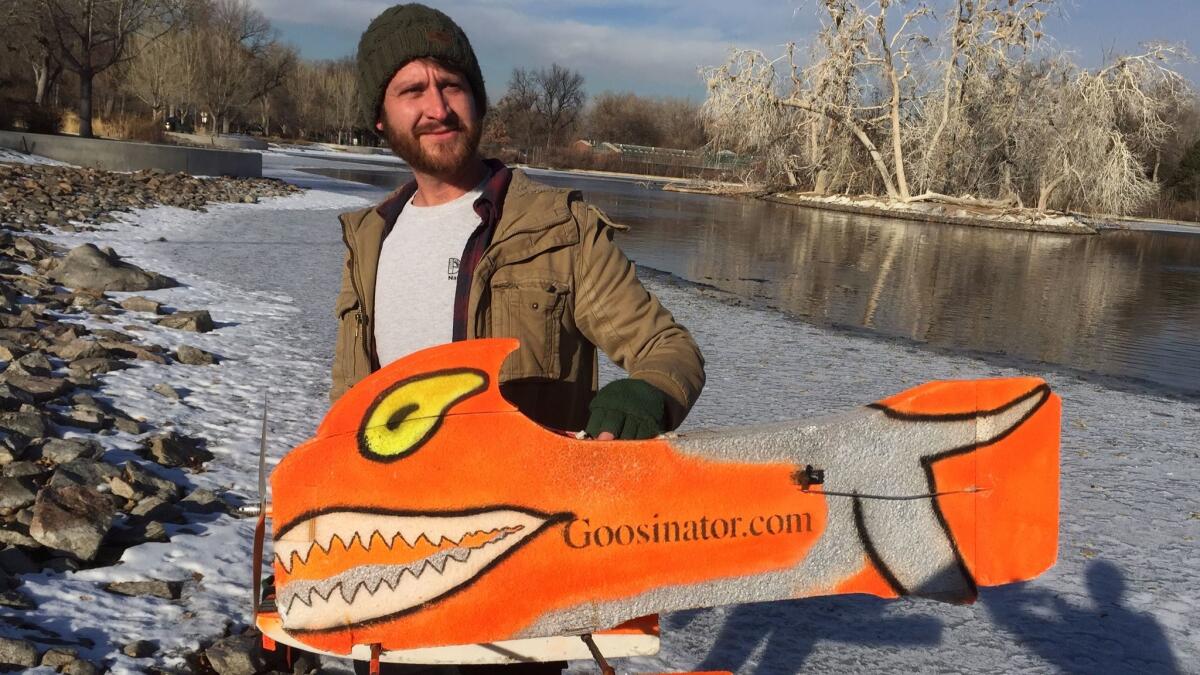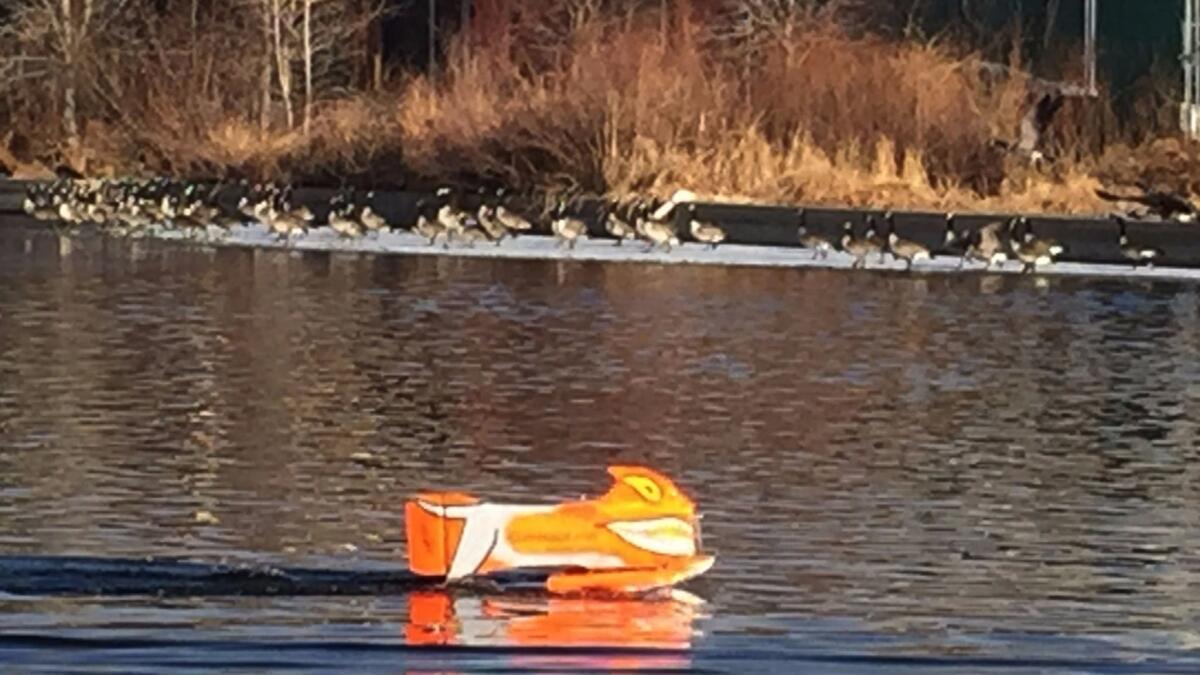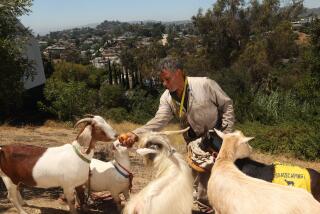Fed up with honking and pooping, Denver gets a ‘goosinator’ to help disrupt Canada goose population

- Share via
Reporting from Denver — On a chilly morning in Denver’s City Park, some 600 Canada geese floated like a drab armada atop an icy pond.
A truck pulled up, and a collective murmur rose from the gaggle, suspicious but not alarmed. Scott Bartell, a technician with the parks department, hoisted out a 3-foot-long, orange contraption festooned with wild eyes and a snarling face.
He plunked it into the pond and switched on the remote control. A shrill whine went up as he slowly steered the gadget toward the geese. The birds panicked, lifting off in a cacophonous rage. In seconds, the pond was clear.
Chalk up another win for the “goosinator,” a critical tool in Denver’s efforts to manage its ever-expanding Canada geese population.
“They’ll fly to the next pond or to a golf course for all those lovingly tended greens they delight in,” said Vicki Vargas-Madrid, wildlife program administrator for Denver Parks and Recreation, watching from shore. “But they’ll come back. From a wildlife perspective, we know we’ll never get rid of geese.”

Winter here usually conjures up images of skiing and snowboarding, but an increasingly telltale sign of the season is the incessant honking of geese overhead.
Colorado’s growing urban goose population and the problems it brings dwarf that of other Rocky Mountain states, experts say. There are about 20,000 to 30,000 resident geese, mostly in populous Front Range cities like Denver, and that can jump to more than 200,000 in winter.
The social, highly adaptable and occasionally testy waterfowl come for the same quality-of-life issues that draw everyone: good food, wide-open spaces and a lack of predators.
“The geese are not necessarily migrating anymore because we have created the perfect habitat for them,” Vargas-Madrid said. “So the population continues to grow and grow.”
With that many birds, some weighing in at 20 pounds, conflicts naturally arise. The geese, easily recognizable with their jet-black heads and white chinstraps, wander into roads, snarling traffic. They nest outside busy stores in planters, charging anyone who comes too close.
Then there is the poop. A determined goose can produce as much as three pounds of droppings per day, which can foul waterways and sidewalks. Dogs delight in eating the stuff, though it can make them sick.
In many ways, the goose boom is a success story, but like so many efforts to manage wildlife, it came with unintended consequences.
Canada geese, which are federally protected, were nearly hunted to extinction in the early 1900s. That led to massive reintroduction efforts throughout much of the U.S. during the 1950s and ’60s. Breeding programs were set up all over Colorado to restore their populations.
“We quickly had as many geese as we wanted,” said Jim Gammonley, avian research leader for Colorado Parks and Wildlife. “For years, we were gathering them up and giving them to other states.”
Now, no one wants them, and even liberal hunting seasons haven’t controlled their populations. States like Minnesota, New York, Michigan and Wisconsin have received federal permission to herd Canada geese into nets during molting season, when they can’t fly, and later gas them. The meat is sometimes donated to food pantries or soup kitchens.
The Humane Society of the United States opposes the practice. “It’s not effective, and as soon as the molting season is over, that empty habitat will be filled by other geese,” said Lynsey White Dasher, director of Wildlife Conflict Resolution for the organization.
She recommended a host of nonlethal methods instead, including trained dogs to chase off the geese.
So far, Denver has resisted calls for more extreme measures.
“A gentleman wrote to me last week saying that we should just kill them all,” Vargas-Madrid said. “Lethal control may be an option in the future, but it is not easy to do and requires a number of permissions. The public would also have to support it.”
A gentleman wrote to me last week saying that we should just kill them all.
— Vicki Vargas-Madrid, wildlife program administrator, on Canada geese in Denver
Instead, wildlife managers employ a variety of techniques to control geese, including spraying their eggs with corn oil, which cuts off oxygen and prevents them from hatching. Denver parks oiled 2,000 eggs in 2016 and hopes to triple that this year.
Wooden cutouts resembling dogs stand like canine scarecrows throughout the metro area to intimidate geese. Rubber coyotes with battery-operated tails are deployed for a more realistic effect.
Country clubs have invited guests to bring their dogs to chase geese off the greens. Strobe lights, lasers and ultrasound devices are stationed around ponds to annoy the birds or disturb their sleep.
But as waterfowl go, geese are quite bright, and they don’t fool easily. If a phony canine isn’t moved daily, the birds will spot the ruse and quickly cavort alongside it. They also will tuck their heads under their feathers to hide from strobes and lasers.
“Most people have no clue how smart they are,” said Randy Clausen, inventor of the goosinator. “They adapt to anything.”
The former hobby shop owner from suburban Lakewood, Colo., became fixated on Canada geese when his brother-in-law couldn’t get rid of the birds at a country club where he worked.
“They were throwing golf balls, doing jumping jacks, anything to get them out of the water,” Clausen said. “Nothing worked, so they asked if there was anything I could do.”
He tried to scare them with a radio-controlled boat, but the birds ignored it. Next came a series of drones shaped like predatory avian. That didn’t fool them either.
Then Clausen unearthed a Cornell University study detailing the deepest fears of a goose. He incorporated them into the goosinator — its name an homage to “The Terminator” — and sold the first one in 2012.
“It mimics real predators like coyotes and bobcats, but accentuates them,” he said. “If you go at them too fast, they recognize it as a human machine, so you stalk and herd them slowly like a predator. There’s a lot of psychology at work here.”
The goosinator, which has a propeller on its nose and glides on foam skis, hounds geese on grass, water, ice and snow.
So far, he’s sold 225 of them for $3,500 each. Denver has seven.
All of these methods require vigilance for days or weeks to keep the birds at bay. And few communities have those kinds of resources.

Some people hassle the geese themselves.
In January, two teenagers were arrested in a drive-by goose shooting in Longmont, near Boulder. The pair cruised through a local park, rolled down the window and began plunking geese with a pellet gun. Witnesses said one bird was hit, but officials couldn’t find it.
Most attitudes are more temperate, though.
Jason Bidgood, 43, is an avid birder who recently stopped by a pond in Denver’s City Park with his binoculars.
“There’s a goldeneye,” he said, pointing to a winsome little duck paddling among a thicket of brawny geese. “There’s a northern shoveler.”
Bidgood isn’t as enamored of Canada geese.
“If you go to the soccer fields, they are covered in bird poop,” he said. “It does seem out of control.”
Shauna Kai, 42, walked her dog, Reilly, nearby.
She enjoys the geese, and Reilly enjoys the poop.
“Well, the geese eat grass, so at least it’s organic,” she said. “It’s the circle of life, I guess.”
Kelly is a special correspondent.
ALSO:
They said he might never walk. Now he can’t stop running
Fearing deportation, a mother in the U.S. illegally seeks refuge in a Denver church
Wet winter has improved Colorado River basin’s water forecast, but it will not end the drought
More to Read
Sign up for Essential California
The most important California stories and recommendations in your inbox every morning.
You may occasionally receive promotional content from the Los Angeles Times.













